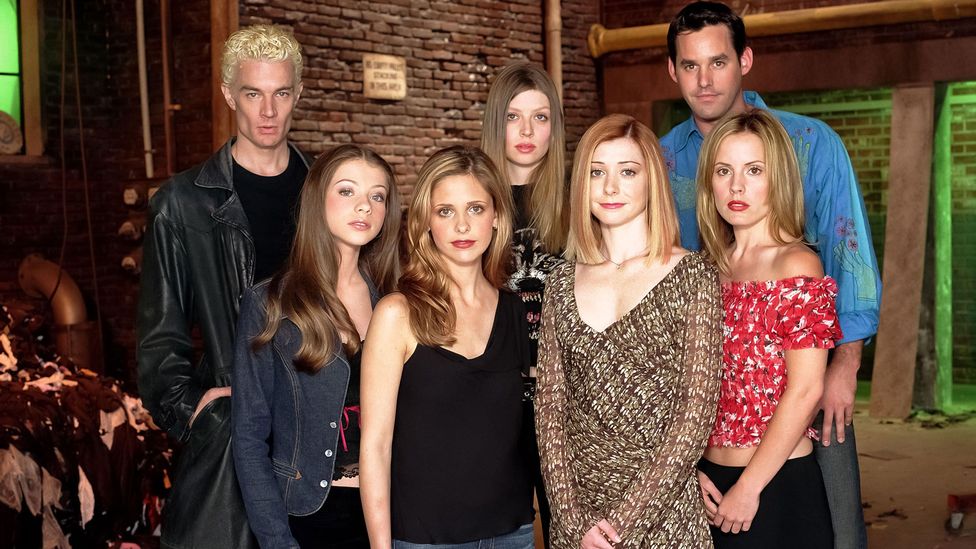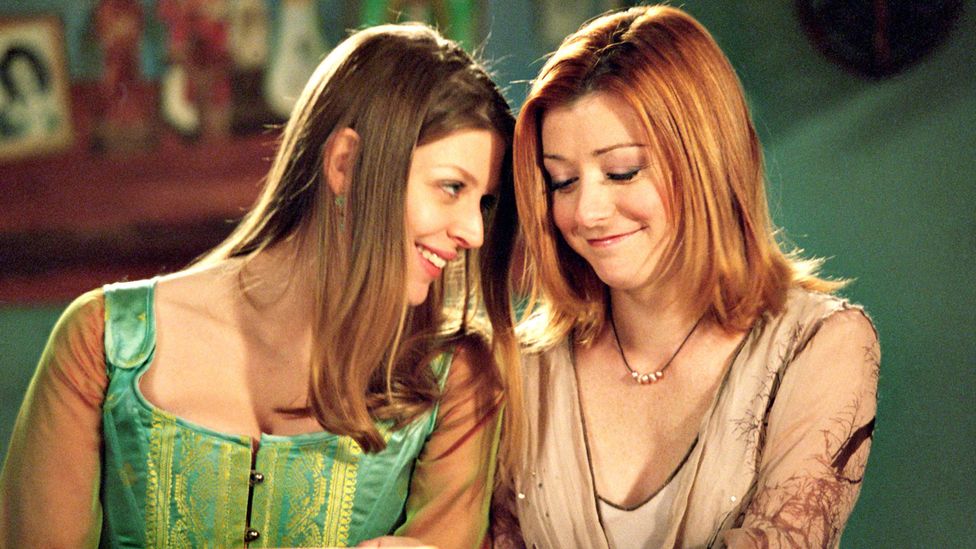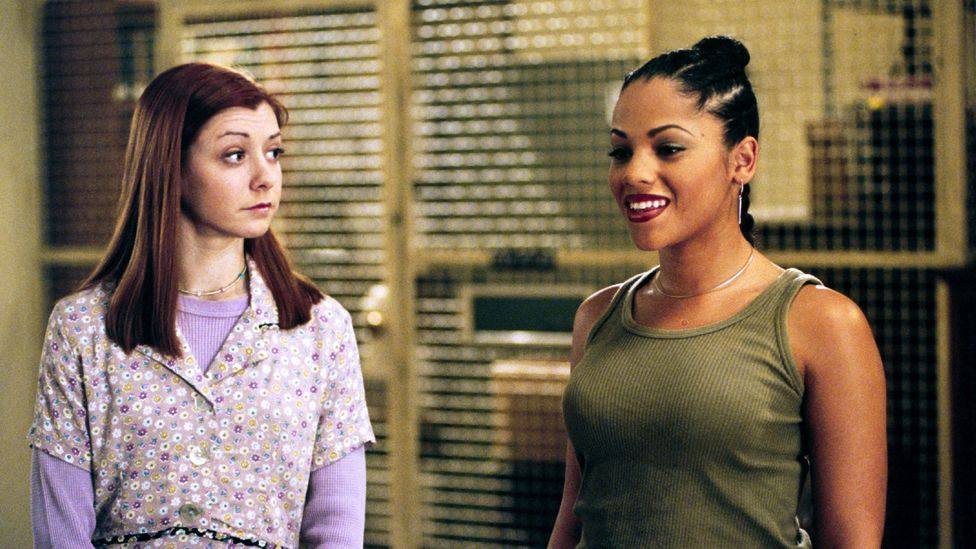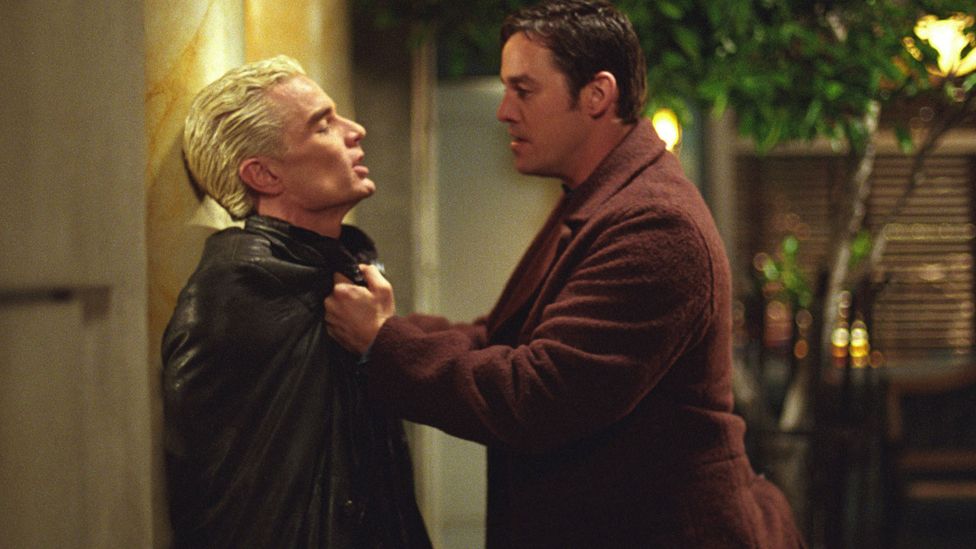Is Buffy tainted forever?

As a UK-based Buffy the Vampire Slayer fan, I can remember the first time I was acquainted with the now era-defining show about a Californian high school girl with the job of protecting humankind from various bloodsuckers, demons and supernatural forces. Limited to five terrestrial channels in our household, I didn’t catch the original British premiere on Sky One – but when it then launched on the BBC, more than a year after its US debut, on 30 December 1998 at 8pm, my brothers and I were glued to our seats to watch Welcome to the Hellmouth, the feature-length season-one opener.
More like this:
– TV’s latest obsessions
– 10 shows to watch in March
– The 100 greatest TV series of the 21st Century
With each new episode and season following the superpowered escapades of Buffy, played by Sarah Michelle Gellar, it acquired a bigger and ever more passionate fanbase. And for me, as for many a schoolgirl and boy at the time, tuning into Buffy became a religious endeavour. Buffy Summers was a badass teen goddess, and I worshipped the hellish ground she slayed on.

Buffy masterfully used horror and fantasy tropes as metaphors for the teen existence (Credit: Alamy)
But now, 25 years ago this week since it first premiered in the US, a cultural reappraisal is happening as fans have increasingly found themselves confronted with certain questions about the show: does it still hold up as the important piece of groundbreaking, feminist television it was once heralded as, in the cold light of 2022? How do they square their ardent affection for the iconic cult series with its more problematic elements? And given the disturbing accusations made by the cast about its creator Joss Whedon and his allegedly “toxic” and “not appropriate” behaviour on set, to what extent should the art be separated from the artist – or not – in this case?
A new take on teen existence
Professor Matthew Pateman, head of English and creative arts at Edge Hill University, first caught on to Buffy as a lecturer in his late 20s. He began including it as part of a popular culture class he taught in the early 2000s, then later in 2006 made it a core feature of his “televisual narratives” module. He has subsequently written a book, The Aesthetics of Culture in Buffy the Vampire Slayer, along with a book about Whedon’s work. “It felt like a really smart, witty, well put together and incredibly fresh piece of television unlike anything else that I was aware of at the time,” Pateman tells BBC Culture. Sure, it was mostly set in a high school but compared to the in-some-ways equivalent Sabrina, the Teenage Witch, it took its audience more seriously, with its dark humour and complex characterisation. “It felt like it was saying, ‘we think you are interesting, grown-up people who want to be interested in interesting grown-up things,'” says Pateman.
Specifically, it took teenage girls seriously. When Whedon first envisioned Buffy in the original 1992 film of the same name, before developing the series for Warner Bros’ newly created WB network (now called CW), he wanted to subvert the pretty blonde stereotype of a young woman whose sole purpose in horror movies had been to scream and be murdered. “I liked the fact that Buffy was the one who makes the monster scream, as opposed to the other way around,” says Becky Darke, a podcaster and writer on film, horror and 90s pop culture. Neither was Buffy forced to sacrifice (well, not entirely) her female interest in fashion, beauty, dating, sex or socialising as a consequence of her heroic destiny. Season one episode Never Kill a Boy on the First Date articulates this brilliantly in a conversation between the Slayer and her father-like Watcher Rupert Giles (played by Anthony Head), tasked throughout with guiding her slayering efforts. “Clark Kent has a job – I just want to go on a date,” she tells Giles. “…and look, I won’t go far, okay! If the apocalypse comes, beep me!”
“There is a great collision between a high-school girl trying to be popular and then having to fight the forces of darkness at night,” says Darke. “I like the fact that she’s allowed to make mistakes, sometimes catastrophic mistakes, but you don’t either give up on her or wish them away; you actually have to watch her deal with them.” Those dark forces manifested in a way that also served as a metaphor for the things teens were dealing with, like when Buffy’s vampire lover Angel (David Boreanaz) becomes a monster after Buffy loses her virginity to him: a demonic reflection of the first-time experience of some young women when confronted with the coldness of young men once they’ve had sex. “The writers handled all of that coming-of-age stuff in a mature, thoughtful way by dovetailing the horror and fantasy elements with the teen existence,” says Marianne McKillop, an English teacher who famously won UK quiz show Mastermind with Buffy as her specialist subject. She cites the example of the season one episode in which a girl “becomes invisible because she’s being ignored at school”, and the “werewolves, you know, sprouting hair and behaving in weird ways”.
As the seasons went on, real issues were dealt with in the foreground rather than the subtext: Buffy’s aspirational California lifestyle was substituted for greater social realism from season five when she is forced to drop out of college and take a job at a suspicious burger joint to look after her high schooler “sister” Dawn (Michelle Trachtenberg) and keep a roof over their heads. “You feel like she should be rich or someone should just be funding her life so that she can do this full time and that’s just not the case,” says actress and writer Isaura Barbé-Brown. Buffy is certainly more Peter Parker than Tony Stark, and that’s what made her so relatable, a quality bolstered by the type of friends she had: the so-called Scooby Gang, who were an eclectic mixture of high-school types. “I also liked the idea that the popular girl might actually decide that the nerdy one is quite fun, and you can form your own clique of outsiders,” says Darke.

The romance between Buffy’s best friend Willow and her fellow witch Tara was an important piece of queer representation (Credit: Alamy)
While the Scooby Gang line-up changed over the seven seasons, Giles, Willow Rosenberg (Alyson Hannigan), and Xander Harris (Nicholas Brendan) were its mainstays, with characters like Cordelia (Charisma Carpenter), Oz (Seth Green), Anya (Emma Caulfield), Tara (Amber Benson) and Spike (James Marsters) thrown into the mix. Most of them evolved into effective and powerful people who could be there for Buffy at home and on the battlefield – none more so than Willow, who transformed from being the nerdy best friend into a mighty witch in one of the series’ most celebrated character arcs. That her sexuality developed as her powers became more prominent led to what remains a monumental moment for queer representation on the small screen. “Her coming out to Buffy was deftly handled,” says Darke. “Her going from this heterosexual relationship with Oz, a fan favourite, then meeting [fellow witch] Tara, and realising that she had feelings for her, [and] that being a beautiful thing that unfolded in front of the audience’s eyes, was just so, so important.”
Buffy and representation
But while Buffy was clearly groundbreaking when it came to representation in some respects, it fell down badly in others. Apart from Bianca Lawson, who played Kendra Young, Buffy’s shortlived fellow Slayer who was killed off in the second season after three episodes, and Ara Celi, who played the Inca Mummy Girl in one episode of season two, women of colour were practically nonexistent until season seven when the so-called Potential Slayers (or slayers-in-training) were introduced, adding slightly more ethnic diversity. “When I was younger, I didn’t really notice [the whiteness of the show] because so much of TV was like that and there was a real segregation between watching the show that has all black people in it and then every other show that just [didn’t] have any,” Barbé-Brown says, noting Buffy’s mostly white writing staff. “I don’t feel like anyone who [was] running the show [was] capable of handling [race].”
And then there were the show’s gender politics: for while it foregrounded many empowered women, it also featured a problematic male lead in the shape of Xander. There were other examples of toxic and fragile masculinity on the show, like the reprisal of teenage boy villains into The Trio in series six, but the difference was that Xander was positioned as a nice guy – and rewatching the series now, that’s something which leaves a particularly bad taste. A pretty girl couldn’t walk by without Xander oggling or pestering them, and it mostly goes unquestioned, especially where Buffy is concerned. His entitled attitude towards her and animosity towards every guy she dates is nauseating to watch. “In the first episode, Buffy drops her books and he says, ‘Can I have you? Oh I mean, can I help you?’ and that line follows him through seven seasons of TV, this feeling of entitlement to her that he never gets to fulfill,” says Darke.
His character could have probably benefitted from the greater self-introspection that the writers afforded to Buffy, Willow, Anya, Angel, Oz and Spike – and maybe even some training. “All these powerful people around, and Xander didn’t even think for a second, ‘let me take a self-defence class,” adds Barbé-Brown. “Nor does he really apologise ever for anything he does or to any of the women in it.”
For better and for worse, the centring of the show on the Scooby Gang showed how much the so-called Chosen One needed her chosen people, even if the narrator states at the beginning of each episode, “she alone will stand against the vampires, the demons and the forces of darkness”. At every turn, the writers counter that narrative. Indeed, Buffy loses her Chosen One status, ending up sharing her mantle with Kendra and later Faith (Elisha Dushku) before every Potential Slayer is activated in the final season. The fact that she and all these Slayers, along with the Scooby Gang and Sunnydale residents, team up in the finale to close for good the Hellmouth (that’s the demonic portal between Earth and Hell, for the uninitiated) suggests that saving the world never needed to be a one-woman job. “One of the brilliant things was that idea that the lone superhero would be absolutely no good,” says Pateman. “She has to be part of a team.”
Behind the scenes though, while also part of a team, Whedon evidently retained a lot of individual power throughout the making of the show: he is credited as a writer on every episode of both Buffy and its spin-off series Angel, while on the DVD commentary of the very first episode of Buffy he quipped that he was “a perfectionist control-freak guy.” In a recent profile of him by Vulture – which he agreed to be interviewed for, and which features multiple sources from the show – Whedon is described as “exerting control over countless aspects of the [Buffy] production, from the story arcs down to the details of makeup and wardrobe,” even as he was running the sets of Angel and another of his shows, Firefly. The article also describes how “a cult of personality” formed around him, with one Buffy writer quoted as saying “the standard reaction to Joss was worship”.

Bianca Lawson, who played Buffy’s fellow slayer Kendra (pictured right), was one of the few women of colour to have a prominent role (Credit: Alamy)
“There [was] a whole heap of other people in the mix and he often presented himself as this young, outsider person who was fighting against the big dogs, which was never really true,” says Pateman. Those other people included Marti Noxon, Doug Petrie, Steven S DeKnight, Jane Espenson, David Fury, Drew Goddard, Drew Greenberg, David Greenwalt and Rebecca Rand Kirshner, all of whom had the most writing credits on Buffy after Whedon. However, in a 2011 interview with the Los Angeles Times, Espenson noted that the show was done “very top down”: “Almost every idea came from Joss [Whedon],” she said. “And we got to sit there and watch him come up with these ideas, talk about how he approaches a story.” If that was the approach, in many ways it worked, to judge by the creative results, certainly, with episodes regularly pushing the boundaries of what a Creature Feature of the week-type series could offer. The episodes Hush, Once More With Feeling, and The Body, in particular, stand out for the innovative techniques used to deliver powerful storytelling; from telling a story in complete silence to creating a dedicated 45-minute musical, to the haunting use of a one-shot to present the most shocking type of death in Buffy the Vampire Slayer – natural causes – these instalments all left viewers in awe, and encouraged repeating viewing.
The limits of its feminism
However season six had fans angry about the direction it took, particularly in its portrayal of its female characters, seemingly switching from celebrating women to bringing them down a peg by having them go through extreme trauma. It saw Willow go dark because of Tara’s murder, Anya go back to her demonic ways after Xander left her at the altar, and Buffy’s (second) resurrection leading her to have hate-sex with Spike, and him eventually attempting to rape her. In fact, Noxon was promoted to showrunner on the final two series, and so found herself heavily criticised for these narrative turns, though she has suggested that Whedon had considerable influence still. “With season six, there was this announcement that I was running the show and Joss was going to take a back seat, but in reality, anybody who knows Joss knows that his idea of taking a back seat is not every single thing, you know?” she told Vulture in 2018. Indeed, at the time Whedon told fans directly on The Bronze Posting Board, maintained on the Buffy website by WB, that he was still in charge: “Marti (She of the great brain and great beauty) and I shaped this year very carefully,” he wrote, “and while we made mistakes (as we do every year), we made our show. We explored what we wanted to, said what we meant. You don’t have to like it, but don’t think it comes from neglect.”
This messaging board was another of Buffy’s innovations: it allowed fans to directly interact with the creators, Whedon especially, way before social media created that sort of online dialogue. “That website made a huge difference, and I think the network executives understood that people were invested in the show and also invested in Whedon,” says Pateman. “[But] the reduction of a creative show to a singular person is always problematic and difficult, and it’s very unfortunate that the reasons that Whedon became such a famous and important television producer, in some respects, are the very reasons that his fall from grace has been so dramatic and astonishing.”
In hindsight, the treatment of women in season six seemed to foreshadow the allegations subsequently made against him by female cast members about his behaviour during the making of the show. According to a message posted on Twitter last year by Charisma Carpenter, who played Cordelia in Buffy and then Angel, Whedon was “casually cruel”, made “ongoing, passive-aggressive threats” to fire her, and after she became pregnant, called her “fat” to colleagues and, in a private meeting with her, asked her if she was “going to keep it”. (Incidentally, several characters in the Buffy-verse, including Cordelia in Angel, die in a pregnancy storyline). After Carpenter spoke out, Michelle Trachtenberg alleged on Instagram there was a “rule” whereby Whedon was not allowed to be alone in a room with her, while on Twitter, Benson corroborated Carpenter’s suggestion that there was a “toxic environment”: “It starts at the top…,” she wrote. “There was a lot of damage done during that time and many of us are still processing it twenty plus years later.”
Whedon once told IGN he was “raised to be a radical feminist” and had a “feminist agenda” with the original film script. He has claimed he wrote himself into the eponymous character – “I was writing about me,” he said in his recent Vulture interview, “and that my feeling of powerlessness and constant anxiety was at the heart of everything.” But this self-image contradicts the one that has been circulating in recent times when it comes to his alleged treatment of women. The BBC has contacted Whedon for a response to the allegations against him, but Whedon has already denied some of them in his interview with Vulture, saying that he had no idea what Trachtenberg was talking about in relation to the alleged “rule”, and asserting that he did not call Carpenter fat and that most of his experiences with her were “delightful and charming”. However he did say that he had behaved in a way that was “not mannerly” towards Carpenter after finding out she was pregnant, and also admitted to having affairs with women on set that “[messed up] the power dynamic”, saying that he felt he “had” to sleep with them, otherwise he would “always regret it”. The latter is the kind of reasoning that suggests he has less in common with Buffy than the entitled male Xander, a character who the showrunner has indeed long admitted to being the basis for.

With his attitude to women, Xander (pictured right) remains perhaps the show’s most problematic character (Credit: Alamy)
Boreanaz, Dushku and Gellar have all distanced themselves from Whedon, with the latter saying on Instagram that even though she is “proud” to have her name associated with Buffy Summers, “I don’t want to be forever associated with the name Joss Whedon.” Undoubtedly, Gellar’s personal contribution to the show’s positive legacy should not be overlooked; her searing, relatable yet complex performance over seven seasons was as important to the show as any credited writer, and her name will, deservedly, be forever synonymous with Buffy’s – as will those of the cast and their array of beloved characters. “They might not have liked what was happening behind the scenes, but the actors loved being a part of this thing that became something else for them because of the fanbase,” says Barbé-Brown. “They will be loved and adored as these characters for generations.”
With all that to consider, has the show’s legacy been irreparably tainted? Whedon’s mission statement of delivering “the joy of female power” does not always seem to have manifested behind the scenes or in front of the camera. And yet, 25 years on, one cannot deny the importance of what Buffy the Vampire Slayer did, in centring several strong female characters within a populist genre format, thereby pushing the boundaries of what was expected from a female-led TV series. But, as with a lot of old shows, including its peers from the 90s, like Friends, it’s hardly a surprise, perhaps, that there are character and narrative elements that have aged badly. “There are some characters that you’re going to look at and go ‘why on earth are they behaving that way?’ but you have to remember that was 25 years ago, and if you can look at it as a period piece, you can still get a lot of modern day benefits from it,” says McKillop, who is rewatching the series with her own daughter. “She’s getting a lot out of it. Not necessarily the same things that I got out of it when I first watched it, but she’s definitely getting some good messages.”
What is very clear is that both old fans and new are more than willing, like Gellar, to separate the show from its creator. “I still think it’s a really good hearted, smart, influential, inspiring show,” says Darke. “Fans have refused to let Whedon sour the show for them. It’s like, ‘well, actually, it’s not yours anymore. It’s ours’.”
Love film and TV? Join BBC Culture Film and TV Club on Facebook, a community for cinephiles all over the world.
If you would like to comment on this story or anything else you have seen on BBC Culture, head over to our Facebook page or message us on Twitter.
And if you liked this story, sign up for the weekly bbc.com features newsletter, called The Essential List. A handpicked selection of stories from BBC Future, Culture, Worklife and Travel, delivered to your inbox every Friday.








